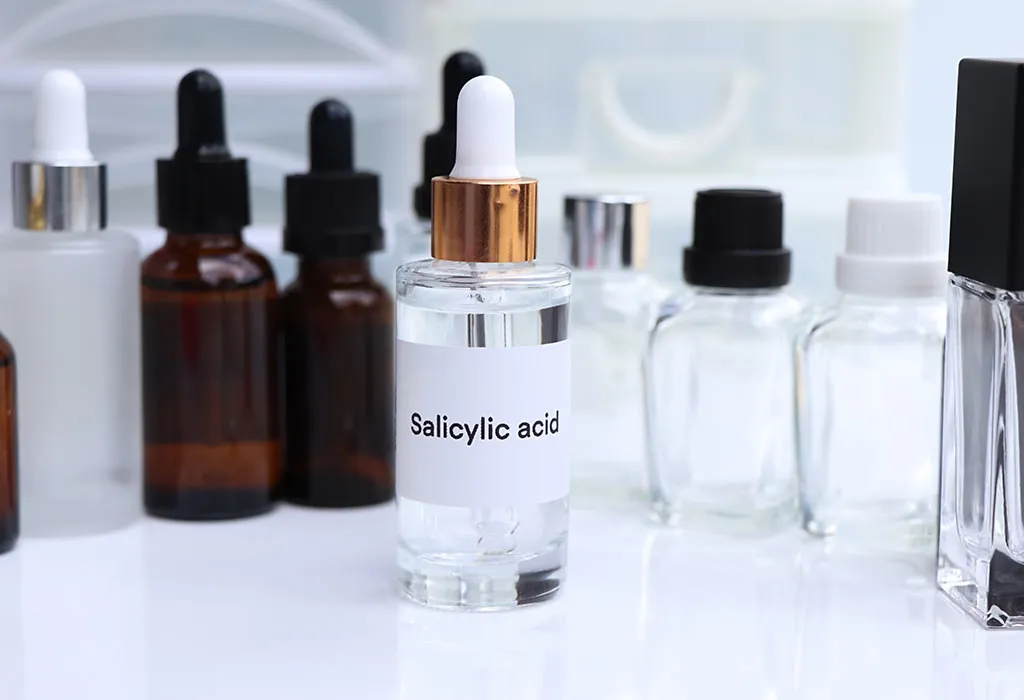Salicylic Acid During Breastfeeding – Is it Safe
Skincare during breastfeeding can feel like a maze, especially when certain ingredients come with warnings and mixed advice. One such ingredient is salicylic acid, a popular choice for treating acne and exfoliating the skin. But as a nursing mom, your baby’s health always comes first, leaving you wondering: Can breastfeeding and salicylic acid coexist in your skincare routine without worry?
The good news is you’re not alone in these concerns, and we’re here to help. In this article, we’ll break down everything you need to know about the safety, recommendations, and expert insights on salicylic acid and nursing. Keep reading to find out how to keep your skin glowing while keeping your little one safe!
What Is Salicylic Acid?
Salicylic acid is an odourless, colourless organic acid belonging to the beta hydroxy acid (BHA) group. It is naturally derived from willow bark and is widely used in skincare for its exfoliating and anti-inflammatory properties (1). It penetrates deep into the skin to remove excess oil, dead skin cells, and impurities. This makes it especially effective for treating blackheads, whiteheads and mild acne.
Is Salicylic Acid Safe During Breastfeeding?
Topical salicylic acid and breastfeeding can be a safe combination, especially when applied in small amounts to the skin. Since topical salicylic acid is minimally absorbed into the bloodstream, it is unlikely to affect your baby (2). Most experts agree that low concentrations, such as those found in over-the-counter skincare products (usually 2% or less), pose little to no risk during breastfeeding.
Benefits of Salicylic Acid When Breastfeeding
Using salicylic acid while breastfeeding can offer several skin benefits without compromising safety. Here’s a quick look at the top benefits of topical salicylic acid for your skin during breastfeeding:
1. Helps Treat Acne
Hormonal changes during breastfeeding can often lead to acne or breakouts. Salicylic acid works by unclogging pores, reducing inflammation, and fighting acne-causing bacteria (3). It can be a gentle yet effective way to manage postpartum acne without the need for harsh oral medications.
2. Reduces Skin Inflammation
Salicylic acid has anti-inflammatory properties, which can help calm irritated or inflamed skin. This is especially helpful for treating conditions like acne, rosacea, or other skin sensitivities that might flare up during breastfeeding.
3. Treats Warts and Calluses
Salicylic acid is also effective in treating common skin issues like warts and calluses (4). It can help soften and remove these growths with consistent application.
4. Treats Dandruff
Dandruff can be a common issue for breastfeeding mothers due to hormonal changes and scalp dryness. Salicylic acid helps exfoliate the scalp and reduce the flaking of dead skin cells (5).
Safety Consideration While Using Salicylic Acid During Breastfeeding
Salicylic acid can be a helpful skincare ingredient, but if you’re breastfeeding, it’s important to use it carefully to avoid any risk to your baby. Here are some safety tips to keep in mind:
- Stick to Low Concentrations: Use products that contain no more than 2% salicylic acid. This amount is typically safe for topical use and less likely to be absorbed into your bloodstream in large amounts.
- Avoid Leave-On Products: Try not to use products that stay on the skin for long periods, like peels or masks, unless approved by your doctor.
- Avoid Areas of Contact With the Infant: Don’t apply salicylic acid to areas that might come into direct contact with your baby’s skin or where it could be ingested by your baby through licking (2).
- Skip Oral Forms: Oral salicylic acid (like aspirin) should generally be avoided during breastfeeding unless prescribed, as it can pass into breast milk and may affect your baby (6).
Some Alternatives to Use While Breastfeeding
Caring for your skin while breastfeeding doesn’t always require special products or treatments. Sometimes, the most effective solutions come from your everyday habits. Here are a few natural ways to support healthy, glowing skin from the inside out.
1. Stay Hydrated
Drinking enough water is one of the easiest and most powerful ways to keep your skin clear and balanced. Breastfeeding can leave you dehydrated, which may reflect dry, dull skin. Aim for at least 8-10 glasses daily, and more if you often feel thirsty (7).
2. Eat a Balanced, Skin-Friendly Diet
What you eat can have a big impact on your skin. Include foods rich in omega-3s like flaxseeds and salmon, antioxidants like berries and leafy greens, and healthy fats like avocados and nuts to nourish your skin from within. Limit sugar and highly processed foods, which can trigger breakouts (8).
3. Get Enough Rest (When You Can)
Sleep might be a luxury right now, but even short periods of quality rest help your skin repair and regenerate (9). Try to nap when your baby does or ask for help so you can catch up on sleep when needed.
When to Call a Doctor?
Taking care of your skin during breastfeeding is important, but it’s just as important to know when something might need medical attention. Here’s when you should reach out to your doctor:
- You have a skin reaction like redness, swelling, or a rash.
- Your baby shows signs of irritation after skin contact.
- A skin issue like acne or eczema doesn’t get better with care.
FAQs
1. Can I use salicylic acid products with other skincare ingredients while breastfeeding?
Yes, but it’s important to be cautious when combining salicylic acid with other active ingredients, such as retinoids or strong exfoliants. Always check the product labels and avoid using too many harsh treatments at once.
2. Can I use salicylic acid if I have a skin condition like eczema or psoriasis?
If you have a skin condition like eczema or psoriasis, it’s important to consult with a doctor before using salicylic acid. While it can help with exfoliating, it might cause irritation on sensitive skin.
3. How often can I use salicylic acid while breastfeeding?
To avoid skin irritation, it’s best to start by using salicylic acid once or twice a week and gradually increase the frequency if needed. Stick to a moderate amount and keep track of your skin’s response.
Motherhood doesn’t come with a pause button, and neither should your self-care. You’ve got enough on your plate; your skin shouldn’t be one more thing to worry about. Salicylic acid can be a reliable ally in your skincare routine, and there’s no reason to shy away from it (as long as you’re using it safely). Keep it simple, listen to your body, and enjoy the journey!
References/Resources:
1. National Library of Medicine – Salicylic Acid
2. National Library of Medicine – Salicylic Acid
3. Narayana Hrudayalaya – Salicylic Acid: Its Uses, Popular Brands & Potential Interactions
6. National Library of Medicine – Aspirin
7. PubMed Central – Water, Hydration and Health
8. Cleveland Clinic – 23 Foods To Eat for Healthier Skin
9. Sleep Foundation – Beauty Sleep: Why Rest and Relaxation Impact Appearance
Also Read:
Are Medications Safe while Breastfeeding?
Apple Cider Vinegar during Breastfeeding
Can You Take Vitamin C While Breastfeeding?
Is It Safe to Have Protein Powder during Breastfeeding?
Was This Article Helpful?
Parenting is a huge responsibility, for you as a caregiver, but also for us as a parenting content platform. We understand that and take our responsibility of creating credible content seriously. FirstCry Parenting articles are written and published only after extensive research using factually sound references to deliver quality content that is accurate, validated by experts, and completely reliable. To understand how we go about creating content that is credible, read our editorial policy here.

























